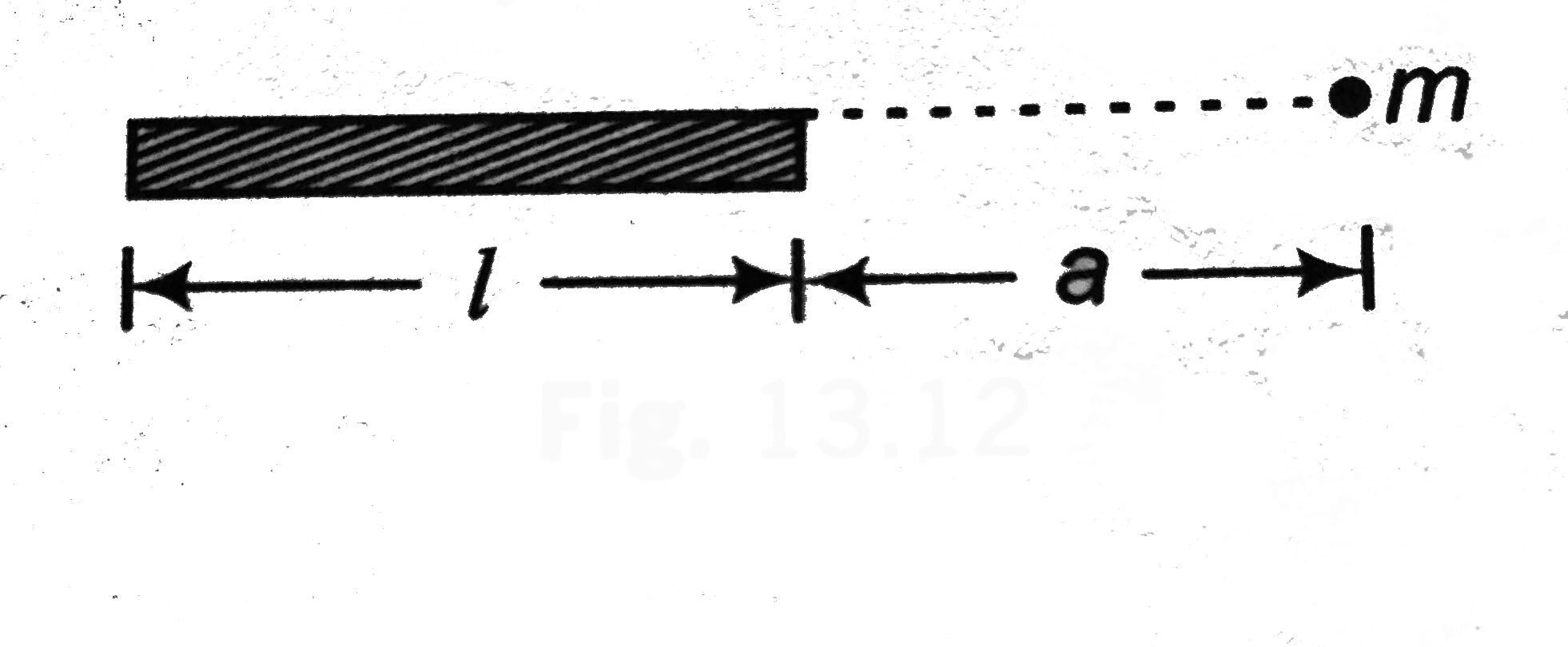A rod of length L is placed along the x-axis between x=0 and x=L. The linear mass density (mass/length) ρ of the rod varies with the distance x from the origin as ρ=a+bx. Here, a and b are constants. Find the position of centre of mass of this rod.
The correct Answer is:A, B, C
To find the position of the center of mass of a rod of length L with a linear mass density that varies with position, we can follow these steps:
Step 1: Define the linear mass density
The linear mass density ρ of the rod is given by:
ρ(x)=a+bx
where a and b are constants.
Step 2: Express the mass of a small element
Consider a small element of the rod of length dx located at position x. The mass dm of this small element can be expressed as:
dm=ρ(x)dx=(a+bx)dx
Step 3: Set up the formula for the center of mass
The position of the center of mass xcm is given by the formula:
xcm=∫L0xdm∫L0dm
Step 4: Calculate the numerator
Substituting dm into the numerator:
∫L0xdm=∫L0x(a+bx)dx=∫L0(ax+bx2)dx
Now, we can compute the integrals:
∫L0axdx=a(x22)L0=aL22
∫L0bx2dx=b(x33)L0=bL33
Thus, the numerator becomes:
∫L0xdm=aL22+bL33
Step 5: Calculate the denominator
Now, we calculate the denominator:
∫L0dm=∫L0(a+bx)dx=∫L0adx+∫L0bxdx
Calculating these integrals:
∫L0adx=aL
∫L0bxdx=b(x22)L0=bL22
Thus, the denominator becomes:
∫L0dm=aL+bL22
Step 6: Combine the results
Now we can combine the results to find xcm:
xcm=aL22+bL33aL+bL22
Step 7: Simplify the expression
To simplify, we can multiply the numerator and denominator by 6 to eliminate the fractions:
xcm=3aL2+2bL36aL+3bL2
Final Result
Thus, the position of the center of mass of the rod is given by:
xcm=3aL+2bL26a+3bL
The linear mass density ρ of the rod is given by:
ρ(x)=a+bx
where a and b are constants.
Consider a small element of the rod of length dx located at position x. The mass dm of this small element can be expressed as:
dm=ρ(x)dx=(a+bx)dx
The position of the center of mass xcm is given by the formula:
xcm=∫L0xdm∫L0dm
Substituting dm into the numerator:
∫L0xdm=∫L0x(a+bx)dx=∫L0(ax+bx2)dx
Now, we can compute the integrals:
∫L0axdx=a(x22)L0=aL22
∫L0bx2dx=b(x33)L0=bL33
Thus, the numerator becomes:
∫L0xdm=aL22+bL33
Now, we calculate the denominator:
∫L0dm=∫L0(a+bx)dx=∫L0adx+∫L0bxdx
Calculating these integrals:
∫L0adx=aL
∫L0bxdx=b(x22)L0=bL22
Thus, the denominator becomes:
∫L0dm=aL+bL22
Now we can combine the results to find xcm:
xcm=aL22+bL33aL+bL22
To simplify, we can multiply the numerator and denominator by 6 to eliminate the fractions:
xcm=3aL2+2bL36aL+3bL2
Thus, the position of the center of mass of the rod is given by:
xcm=3aL+2bL26a+3bL
Topper's Solved these Questions
- BOOK - DC PANDEY ENGLISHCHAPTER - CENTRE OF MASS, LINEAR MOMENTUM AND COLLISIONEXERCISE - Type 11videos
CENTRE OF MASS, LINEAR MOMENTUM AND COLLISION
- BOOK - DC PANDEY ENGLISHCHAPTER - CENTRE OF MASS, LINEAR MOMENTUM AND COLLISIONEXERCISE - Solved Examples13videos
CENTRE OF MASS, LINEAR MOMENTUM AND COLLISION
- BOOK - DC PANDEY ENGLISHCHAPTER - CENTRE OF MASS, IMPULSE AND MOMENTUMEXERCISE - Comprehension type questions15videos
CENTRE OF MASS, IMPULSE AND MOMENTUM
- BOOK - DC PANDEY ENGLISHCHAPTER - CIRCULAR MOTIONEXERCISE - Medical entrances s gallery19videos
CIRCULAR MOTION
Similar Questions
A rod of length L is placed along the X-axis between x=0andx=L. The linear density (mass/length) ρ of the rod varies with the distance x from the origin as ρ=a+bx. a.) Find the SI units of a and b b.) Find the mass of the rod in terms of a,b, and L.
View SolutionThe density of a thin rod of length l varies with the distance x from one end as ρ=ρ0x2l2. Find the position of centre of mass of rod.
View SolutionLinear mass density of a rod AB(of≤n>h10m) varies with distance x from its end A as λ =λ0x3 (λ0 is positive constant) . Distance of centre of mass of the rod , from end B is
View SolutionA thin rod of length 6 m is lying along the x-axis with its ends at x=0 and x=6m. Its linear density *mass/length ) varies with x as kx4. Find the position of centre of mass of rod in meters.
View SolutionLinear mass density of a rod AB ( of length 10 m) varied with distance x from its end A as λ=λ0x3 (λ0 is poitive constant). Distance of centre of mass the rod, form end B is
View SolutionA metal rod extends on the x−axis from x=0m to x=4m. Its linear density ρ (mass/length) id not uniform and varies with the distance x from the origin according to equation ρ=(1.5+2x)kg/m What is the mass of rod:−
View SolutionA thin rod of length L is lying along the x-axis with its ends at x=0 and x=L its linear (mass/length) varies with x as k(xL)n, where n can be zero of any positive number. If to position xCM of the centre of mass of the rod is plotted against 'n', which of the following graphs best apporximates the dependence of xCM on n?
View SolutionA mass m is at a distance a from one end of a uniform rod of length l and mass M. Find the gravitational force on the mass due to the rod.
 View Solution
View SolutionA mass m is at a distance a from one end of a uniform rod of length l and mass M. Find the gravitational force on the mass due to tke rod.
 View Solution
View SolutionThe density of a non-uniform rod of length 1m is given by ρ(x)=a(1+bx2)
where a and b are constants and 0≤x≤1.
The centre of mass of the rod will be atView Solution

